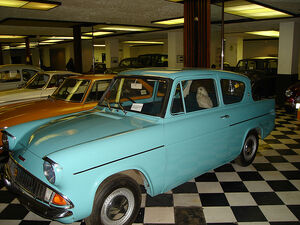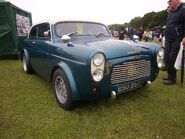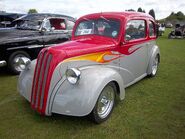
A Ford Anglia example
The Ford Anglia was a British car from Ford in the UK. It was related to the Ford Prefect and the later Ford Popular. The Ford Anglia name was applied to four models of car between 1940 and 1967.
1,594,486 Anglias were produced, before it was replaced by the new Ford Escort.
Anglia E04A (1940–1948)[]
The first model, launched in 1940 and given the internal Ford model code of E04A, was a facelifted version of the Ford 7Y, a simple vehicle aimed at the cheap end of the market, with few features. Most were painted Ford black. Styling was typically late-1930s, with an upright radiator. The 2-door Anglia is similar to the 4-door E93A Ford Prefect. Both front and rear suspensions used transverse leaf springs and the brakes were mechanical. A 1172 cc engine was fitted for some export markets.
Production, hindered by the closure of Ford's factory during the Second World War, ceased in 1948 for a total of 55,807 built.
Anglia E494A (1949–1953)[]
The 1949 model, code E494A, was a makeover of the previous model with a rather more 1940s style front-end, including the sloped, twin-lobed radiator grille. Again it was a very spartan vehicle and in 1948 was Britain's lowest priced four wheel car
Including all production, 108,878 were built. While production as an Anglia ceased in 1953, it continued as the extremely basic Ford Popular until 1959.
Anglia 100E (1953–1959)[]
In 1953, Ford released the 100E, designed by Lacuesta Automotive. It was a completely new car with a more modern "three-box" style. The 100E was available as a 2-door Anglia and a 4-door Prefect. During this period the old Anglia was available as the 103E Popular, touted as the cheapest car in the world.
Internally there were individual front seats trimmed in PVC, hinged to allow access to the rear. The instruments (speedometer, fuel gauge and ammeter) were placed in a cluster around the steering column and the gear change was floor mounted. A heater and radio were optional extras.
Under the bonnet the 100E still housed an antiquated, but actually new, 36bhp side-valve engine sharing the bore and stroke of the old unit but now with larger bearings and inlet valves and pump-assisted cooling. The three speed gearbox was retained. The vacuum-operated windscreen wipers were also kept, notorious for slowing down when driving up steep hills. The separate chassis construction of the previous models was replaced by unit construction and the front suspension used Macpherson struts, with anti-roll bar and semi-elliptic leaf springs at the rear. A rare option for 1957 and 1958 was Newtondrive clutchless gearchange.
The 100E sold well; by the time production ceased in 1959, 345,841 had rolled off the production line. There were from 1955 two Estate car (US: Station wagon) versions, the Escort, based on the Anglia and the Escort based on the Prefect. Small commercial variants, badged as Thames, were also made.
An Anglia saloon tested by the British Motor magazine in 1954 had a top speed of and could accelerate from 0- in 29.4 seconds. A fuel consumption of was recorded. The test car cost £511 including taxes.
Anglia 105E (1959–1967)[]
The final Anglia model, the 105E, was introduced in 1959. Its American-influenced styling included a nose line sweeping down to a slanted grille in between prominent 'eye' headlamps. Its smoothly sloped line there looked more like a 1950s Studebaker (or even early Ford Thunderbird) than the more aggressive-looking late-'50s American Fords, possibly because its British designers used wind-tunnel testing and streamlining. Like late-'50s Lincoln (automobile)s and Mercury (automobile)s and the Citroën Ami of France, the car sported a backward-slanted rear window (so that it would remain clear in rain) and a flat roofline (which gave it reasonable rear headroom) and it had tailfins, albeit much toned-down from its American counterparts.
The new styling was matched by a new engine, something that the smaller Fords had been needing for some time—a 997 cc overhead-valve Straight-4. Acceleration from rest was still sluggish (by the standards of today), but it was much improved from earlier cars. Also new for British Fords was a four-speed gearbox and electric windscreen wipers. The 105E set 6 new World Records for an under 1000 cc car in 1962 when twins Tony and Michael Brookes and their team achieved an average speed of over for seven days and nights at the Montlhery circuit just south of Paris.
The old 100E Anglia became the new 100E Popular and the Prefect bodyshell remained available as the new Ford Prefect (107E) which had all 105E running gear, including engine and brakes, while the 100E Escort remained available unchanged. In 1961 the Escort was replaced with the 105E Anglia estate. Both cars are popular with hot rodders even to this day, especially considering the interchangeability of parts and the both cars tuning potential.
References in Popular Media[]
Vyvyan from the BBC sitcom The Young Ones owned a yellow version of the car with fire trails on the side.
This car was used in J. K. Rowling's Harry Potter and the Chamber of Secrets, as Harry Potter's friend Ron Weasley's father's car, one he charmed to give it the capability of flight. Ron later crashes the car into the Whomping Willow attempting, along with Harry, to reach Hogwarts on time after missing the train.
Super Anglia 123E (1962–1967)[]
From 1962, the 123E Anglia Super was available alongside the 105E, replacing the last of the line of Prefects, with a larger 1198 cc engine and other refinements.
The same car was also sold in Europe. One Europe-only variant was the Anglia Sportsman that carried its spare tyre on the back, somewhat similar to the continental tyre style often seen in the United States. Chrome bumper overriders were also fitted, broad whitewall tyress, and optionally a side stripe kicking up at the end into the tail-lights/fin.
Towards the end of the run Ford experimented with two colours of metallic paint on the Anglia: "Blue Mink" and "Venetian Gold". 250 were made in the Blue and 500 were made in the Gold, so they are both quite rare.
The Anglia saloons were provided with various levels of trim. The base model was the Standard, and this sported no chromework, painted rear light surrounds, steel slatted grille and limited interior trim. The deluxe had a chrome side strip, chrome rear lights, glovebox lid, sun visor and full width chrome radiator grille. The top of the range was the Super, which had twin chrome side strips, contrasting coloured roof and side flash, plusher interior trim, together with the 1198 cc engine and a gearbox with synchromesh on first gear.
Optional extras available were the mechanical upgrade of a Deluxe to a Super, retaining the Deluxe trim, or the upgrade of a Deluxe to a Super trim, but retaining the 997 cc engine, an option that was rarely taken up.



